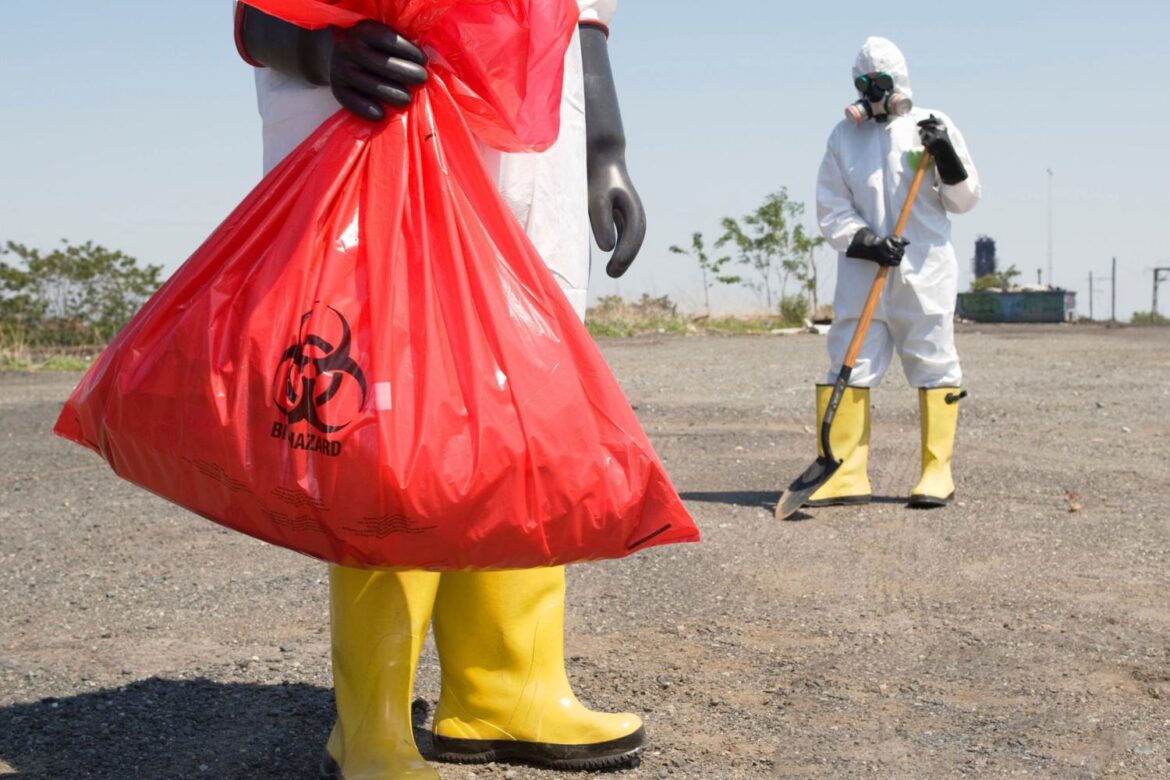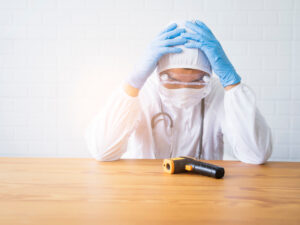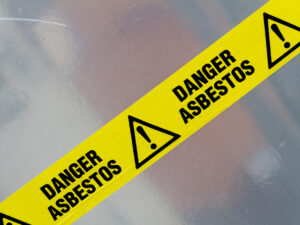
When we think about workplace safety, our minds often jump to immediate, visible threats: heavy machinery, slippery floors, or falling objects. We diligently wear hard hats, steel-toe boots, and high-vis vests to protect ourselves from these clear dangers. But what about the threats we can’t see? In the bustling ecosystem of a workplace, few areas are as ripe for invisible hazards as the employee changeroom.
Often damp, warm, and frequently used, changerooms are a critical nexus for hygiene and health. Unfortunately, this also makes them a potential hotspot for the transmission of Hazardous Biological Agents (HBAs). These microscopic organisms (bacteria, viruses, fungi, and other pathogens) can pose a significant risk to employee health, leading to illness, reduced productivity, and increased absenteeism.
For facility managers, safety officers, and employees alike, understanding these risks is the first step toward creating a safer, healthier work environment. Let’s dive into the common HBAs found in changerooms, how they spread, and, most importantly, how they can be effectively controlled.
Hazardous Biological Agents (HBAs) in a Changeroom
HBAs are biological substances that pose a threat to human health. In the unique environment of a changeroom, they typically originate from the human body itself, brought in on soiled work clothes, skin, and personal items. The warm, humid conditions provide the perfect breeding ground for them to multiply.
The most common categories include:
Bacteria: These are prolific in changerooms. Key examples include:
- Staphylococcus aureus (including MRSA): Often found on the skin and in the nose, it can be transferred via shared towels, benches, or equipment. MRSA is a drug-resistant strain that can cause serious skin infections and pneumonia.
- Escherichia coli (E. coli) and other gut bacteria: Brought in on soiled clothing, especially in industries like agriculture, waste management, or healthcare. Certain strains can cause severe gastrointestinal illness.
- Pseudomonas aeruginosa: Thrives in moist environments like damp floors, drains, and shower areas. It can cause skin rashes (“hot tub rash”) and ear infections.
Fungi: The constant moisture makes changerooms a paradise for fungi.
- Dermatophytes: These cause fungal infections like Athlete’s Foot (tinea pedis) and ringworm. They spread through shed skin flakes on floors, mats, and shared showers.
- Moulds: Can grow on walls, ceilings, lockers, and in ventilation systems if humidity is not controlled. Mould spores become airborne and can trigger allergic reactions, asthma attacks, and respiratory issues.
Viruses: The common cold and influenza (flu) viruses can survive on hard surfaces like locker handles and faucets for several hours. They are easily transferred from hand to mouth, nose, or eyes.
Other Biological Matter: While not infectious agents themselves, other biological materials can cause problems. Dust mites thrive in fabric and feed on dead skin cells, a major allergen for many people. Pollen can be brought in on work clothes from outdoor sites, affecting those with hay fever.
How Do These HBAs Spread? Understanding the Vectors
The spread of these agents in a changeroom is rarely due to a single cause. It’s usually a combination of environmental factors and human behaviour.
Surface Contact (The Most Common Route): This is the primary transmission pathway. An infected person sheds pathogens onto a surface via their skin, sweat, or contaminated clothing. The next person who touches that surface can pick up the pathogen. High-touch points are major culprits:
- Bench seats and locker handles
- Shower and faucet controls
- Door handles and push plates
- Shared equipment (e.g., hair dryers)
- Floor surfaces in showers and changing areas
Airborne Transmission: While less common for some agents, activities like shaking out dirty work clothes or towels can aerosolize dust, skin flakes, and fungal spores. Mould will also release its spores into the air, which can be inhaled.
Direct Person-to-Person Contact: This can occur through direct skin contact or through the sharing of contaminated personal items like razors, towels, bar soap, or clothing.
The “Dirty to Clean” Cross-Contamination: This is a critical concept. The journey from the work area to the changeroom often brings heavy contamination. If the design doesn’t separate “dirty” areas (where soiled work clothes are removed) from “clean” areas (where street clothes are stored and showers are), employees can easily track pathogens throughout the entire space.
Building a Defence: A Multi-Layered Approach to Control
Controlling HBAs is not about one magic solution; it’s about implementing a robust, multi-layered strategy that combines facility design, cleaning protocols, and behavioural policies.
Layer 1: Facility Design and Engineering Controls
Zonal Separation: Design changerooms with a clear, one-way flow. Employees should enter a “dirty” zone to remove and store work clothes and PPE. They then proceed through showers (if available) to a “clean” zone where their personal clothing and belongings are stored. This physically contains contaminants.
Adequate Ventilation: Install and maintain ventilation systems that provide a sufficient number of air changes per hour. This helps reduce humidity levels (critical for controlling mould and fungi) and removes airborne contaminants. Ensure extractor fans in showers are working effectively.
Material Selection: Choose building materials that are non-porous, easy to clean, and moisture resistant.
- Floors: Use seamless, anti-slip vinyl or epoxy flooring that can withstand frequent wet cleaning and disinfecting.
- Walls/Ceilings: Use coated plasterboard, fibreglass, or PVC panels instead of porous materials like untreated wood.
- Benches: opt for stainless steel or plastic seating instead of porous wood.
Amenities: Provide enough lockers (with ventilation slats), showers, and changing space to prevent overcrowding.
Layer 2: Robust Cleaning and Disinfection Protocols
- Frequency and Diligence: High-touch surfaces must be cleaned and disinfected multiple times per day—not just once at the end of the day. Floors, especially in showers, should be cleaned daily.
- The Right Products: Use EPA-approved disinfectants that are effective against a broad spectrum of pathogens (bacteria, viruses, and fungi). It’s crucial to follow the manufacturer’s instructions for dilution and contact time—the surface must remain wet with the disinfectant for the specified duration (often several minutes) to be effective. Simply wiping it off immediately is useless.
- Tools and Technique: Colour-code cleaning equipment (e.g., red for dirty zones, green for clean zones) to prevent cross-contamination. Use microfiber cloths, which are more effective at capturing microbes than traditional cotton cloths.
- Waste Management: Provide foot-operated, lined bins for the disposal of sanitary waste and used towels to prevent hand contact with contaminants.
Layer 3: The Critical Role of HBA Monitoring
You can’t manage what you don’t measure. While preventative controls are essential, proactive monitoring is what closes the loop, providing data to validate that your controls are working and identifying problems before they lead to an outbreak.
Environmental Monitoring:
- Air Quality Monitoring: Use hygrometers to continuously track relative humidity levels, ensuring they remain below 60% to inhibit mould and fungal growth. Particle counters can also be used to measure airborne particulate levels, which can indicate elevated levels of dust, skin flakes, or mould spores.
- ATP Testing: Adenosine Triphosphate (ATP) is a molecule found in all living cells. ATP monitoring systems use a luminometer to measure the amount of organic residue on a surface after cleaning. While it doesn’t identify specific pathogens, it provides a rapid (15-30 second) “hygiene verification” score. A high reading indicates poor cleaning effectiveness and a high risk of HBA presence, allowing for immediate corrective action.
Microbiological Monitoring:
- Surface Swabbing: This is a more specific method. Regular swabs of high-touch surfaces (door handles, taps, bench seats) are sent to a laboratory for culture and analysis. This can identify the types and levels of bacteria (e.g., Total Viable Count, TVC) or the specific presence of pathogens like E. coli or Staph. aureus. This is typically done less frequently (e.g., quarterly or in response to an incident) due to the longer turnaround time for results.
- Air Sampling: In cases where mould is a suspected issue or for high-risk environments, air samplers can be used to collect airborne particles for lab analysis to identify and quantify mould spores or other airborne biological agents.
Visual and Olfactory Audits: Never underestimate the power of routine, scheduled inspections. Checklists should include looking for signs of mould, mildew, water damage, clogged drains, and general cleanliness. A musty smell is a clear, immediate indicator of a mould or moisture problem that needs investigation.
Layer 4: Administrative Controls and Employee Education
Technology and design mean little without the right behaviours. Education is paramount.
Clear Signage: Place signs reminding employees to wash hands, wipe down benches after use, and report any maintenance issues like leaks or clogged drains.
Hygiene Policies: Implement and communicate clear policies:
- No shared towels or personal items.
- Proper handwashing: Encourage washing hands before and after using the changeroom.
- Shower etiquette: Encourage showering with soap before leaving work, especially if working with hazardous materials.
- PPE Use: Provide and mandate the use of flip-flops or shower shoes in wet areas to prevent Athlete’s Foot.
Laundry Services: For high-risk industries, provide a workwear laundry service. This ensures contaminated clothing is professionally cleaned and prevents employees from taking biohazards home to their families.
Maintenance Schedule: Have a strict, documented schedule for inspecting and maintaining ventilation systems, cleaning drains, and repairing any water damage immediately to prevent mould growth.
A Data-Driven, Shared Responsibility
A safe changeroom is not a luxury; it’s a fundamental component of a comprehensive workplace health and safety program. The risks posed by Hazardous Biological Agents are real but entirely manageable.
By investing in smart design, enforcing rigorous cleaning standards, implementing a proactive monitoring regime to gather crucial data, and fostering a culture of personal hygiene and shared responsibility, employers can transform the changeroom from a potential hazard zone into a clean, safe, and healthy space. This data-driven approach protects one of a company’s most valuable assets: its people. The goal is to ensure that when employees change out of their work clothes, the only thing they leave behind is the dirt from the job, not an invisible threat to their health.








